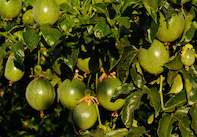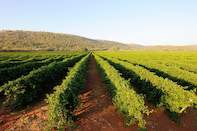The passion fruit or granadilla well-known in South Africa is the purple variety named ‘Ester’ a combination of the small purple granadilla (Passiflora edulis f edulis) and the yellow (Passiflora edulis f flavicarpa) granadilla.

This thick-skinned fruit has aromatic sweet and acidic flesh that can be eaten fresh but is most commonly processed to granadilla pulp used in desserts, cakes, juice and liqueurs.
Granadilla production worldwide is focused in tropical and subtropical areas of the world.
World Production of Granadillas
The purple and yellow passion fruit types are native to Brazil, cultivated by the Aztecs and till today, Brazil remains the world’s top producer of granadillas. It was introduced to Europe in 1629 by Spanish missionaries who returned from Brazil.
Analysing production data shows that big production countries are not necessarily big exporters of fresh granadillas. For example, Brazil is by far the largest producer in the world with about 600 000 tonnes a year (2018) but most of this is exported as concentrated granadilla juice. China is the biggest producer of granadillas in Asia, but most of this is consumed in China.
Granadillas are commercially grown in Hawaii, Australia, New Zealand and other South American countries such as Venezuela, Peru, Ecuador, Argentina, Paraguay and Colombia. Most of the Latin American countries produce yellow passion fruit, preferred in the processing industries of these countries. Colombia produces purple and yellow passion fruit and sweet granadilla, a fresh export speciality.
The main suppliers of fresh purple passion fruit to the European market are Kenya, South Africa and Colombia. Ghana and Burundi export smaller quantities. Yellow passion fruit for the European market is shipped mainly from Thailand and Colombia.
Colombia is one of South Africa’s main competitors as it produces granadillas for 12 months of the year.
In Africa, the main granadilla producers were Kenya (heavy recent losses due to die-back disease and Zimbabwe (political turmoil caused an agricultural collapse). Other smaller granadilla producing countries in Africa are Burundi and Rwanda. Production and export in Ghana are increasing. This is due to German retailers buying into local farms and the Ghanian government subsidising air freight costs, says Kobus Germishuizen of Stilhoek Farms, South Africa’s largest granadilla producer.
South African Production of Granadillas

Optimum granadilla production in South Africa is mainly along the south and east coasts of South Africa, with areas in higher altitudes in KwaZulu-Natal, Eswatini (Swaziland), but mostly in the Limpopo and Mpumalanga provinces. It is estimated that about 200 ha of granadillas are planted in South Africa.
The high levels of vitamin A and C make granadillas a healthy fruit choice. This has led to an increase in demand and exports from South Africa. South Africa is one of the top-5 exporters of fresh granadillas to the European Union, just after Colombia, Vietnam and Kenya.
Top importing countries of South African granadillas are Germany, Switzerland and France where larger fruit (over 100g each) such as count 18 - 20 are preferred. The UK markets have a preference for smaller fruit (count 25 - 30 or smaller). The ‘count’ is an indication of the number of fruit per 2kg box.
South African granadilla farmers compete with countries such as Colombia and Vietnam. Colombian farmers enjoy government-subsidised shipping costs which ensure lower base prices in the retail market and Vietnam produces very large fruit, prefered in certain markets.
Around 60% of South Africa’s granadilla production is sold fresh and about 40% is processed. Of the fresh fruit, about 85 - 90% is exported.
Granadillas from South Africa are packed in 2kg cartons and depending on the specific market or retail, may include packaging adaptation such as plastic liners or modified atmosphere packaging. All South African granadillas are air freighted.
According to Johan Husselman, a plant breeder at the Agricultural Research Council’s Tropical and Subtropical Crops Division (ARC-TSC) South African granadilla research focuses on new cultivars with higher yield and disease resistance, a larger size and improved eating qualities such as taste and better fill.
By Marinda Louw